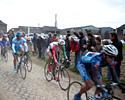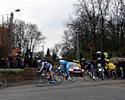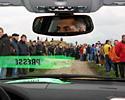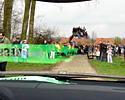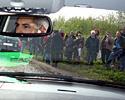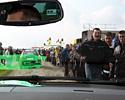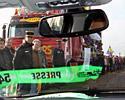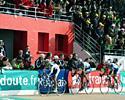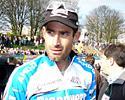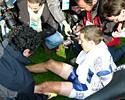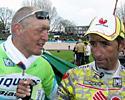
Recently on Cyclingnews.com |
Tales from the peloton, May 10, 2005
No ordinary day at the office, part 2: Hammer time
It's May and we're already at the Giro, but before the memories of the Spring Classics fade, Gerard Knapp takes us on a trip in the Cyclingnews 'stretch limo', bottoming out on the pavé as the crew covered Paris-Roubaix. Back to part 1.
It's only ever 'full-speed-ahead' on the pavé. In the first sections of pavé in the 2005 Paris-Roubaix parcours, noticeably smoother than those of the brutal Orchies (12) and the Carrefor de l'Arbre (4), the peloton was together, save for the inevitable suicide break that characterizes many of the Classics.
To have almost 200 cyclists thundering downhill - the pavé does have slight up and downhill sections - is truly frightening to small children and livestock, while spectators are either screaming encouragement or awe-struck. The ground rumbles as the riders steam past, staying together as they would on bitumen, until the course begins to take its toll, and after only one or two sectors, there was a pile-up towards the rear.
Then, the following entourage of team cars, press cars and support vehicles skid to halt, like a giant accordion being squeezed together by an invisible force. They're unable to pass as the 'roads' are too narrow, and usually lined with spectators. For riders who have fallen or flatted and need assistance, this can spell the end of their chances on the day, like Peter van Petegem, who waited for over two minutes to get a wheel-change.
Following the race as a spectator is possible by leap-frogging around the sections of pavé, but local knowledge is essential to navigate one's way through the network of poorly marked back roads in the northern French countryside. As usual, the Belgians are experts; not only are they passionate about these races in April, they're also highly knowledgeable about the events, the riders and getting around the parcours without a race permit.
As the Cyclingnews crew cooled its heels on the side of the course at pavé sector 23 (early in the race - the sectors are counted down) while our photographer, Jonathan Devich, set up his shots, we encountered Andre Boonen, Tom's father, and his younger son (who is a dead-ringer for Tom, with the same haircut), chaperoning Lance Donnell from Sinclair Imports, the American importer of Ridley Bicycles. "This guy knows the place backwards!" Donnell said, "and he knows everybody." Not surprisingly, Andre, who would appear to enjoy his Belgian beer and frites, also sells a lot of Ridley bikes in Europe.
After the publicity caravan has bounced through - the mobile advertisements in Paris-Roubaix are based on ATVs and the like - the police come charging through on their enduro bikes, then the cyclists. Witnessing the speed of the peloton charging onto the pavé is like watching the best climbers go uphill; it never ceases to amaze, particularly if you have an inkling of what's involved.
Once the entourage has rolled through, many in the crowd quickly head off to their cars and charge on, navigating their way through the back-roads in the hope of catching another glimpse of their heroes.
On the most brutal sectors of pavé, the crowds are at their thickest and most eccentric. There are flat-bed 40-tonne trucks parked in the fields - useful as large viewing platforms - as well as the usual caravans and tents for the hardcore fans (French farmers are seemingly quite accommodating to overnight campers). There were at least two brass-bands in full fancy-dress within 20km of each other - one can only wonder if a rider has been distracted by all this frivolity and fallen, as they tend to set up on very poor sectors of pavé.
Going by the flags and the amount of beer being consumed, most of these fans are Belgian. Their passion gives the race its atmosphere, like the big climbs in the Alps or Pyrenees, where massive crowds form alongside roads that are otherwise deserted for most of the year.
But as the route goes through many small villages, other spectators do no more than put on their overcoats and walk out their front door, unfold picnic chairs outside their houses and take up viewing positions some 10 minutes before the riders roll through.
In the small villages, the townsfolk are somewhat different to the French people you meet in Paris, you could say. As Cyclingnews took another break from the 'road' and pulled into the en-route village of Tilloy-lez-Marchiennes, our reporter Hedwig Kroner needed to find a rest-room. In her flawless French, she asked a local woman for directions, who instead invited her into her home. I then pushed our luck and asked Hedwig to ask her where we could obtain something to eat, given we were 10 minutes ahead of the field. The Frenchwoman used her mobile phone and called her brother - who ran the local café - and phone-ordered through three fromage baguettes. Did she notice the accreditation tags? I doubt it. Country people are pretty friendly the world over.
Fast than a speeding Focus
Cyclingnews re-entered the parcours at sector 14 (and thanks again to Ms Kroner's perfect French, a gendarme even moved a barricade) only five kilometers ahead of the leaders. From Hornaing à Wandignies through to Hem (sector 2), the turbo-charged Cyclingnews stretch limo (well disguised as a Ford Focus carrying an all-important green pass), could not pull away from the leaders of the race.
Despite our best efforts to do otherwise, it was like we were in danger of being caught by Boonen, Hincapie and co. No matter how we tried to push it through the pavé, race radio kept telling us they weren't far behind. We would receive an update - like when poor Lars Michaelsen (CSC) supposedly flatted* on sector 4 with under 15km to go, we were still only minutes ahead. At this stage our photographer was worried we may not have enough time to get into Roubaix, park behind the velodrome and get onto the infield for the finish, such was the intensity of the leading group.
We couldn't use the old trick of putting one set of the car's wheels on the crown of the cobbles, and run the other set in the muddy gutter (I wouldn't say 'shoulder') because it was lined with screaming Belgians waving their Flandrian flags and drinking copious amounts of beer. No, the car had to follow the pavé into the deep trenches that form in the wheel-tracks and here, the cars are down to first gear and scraping the under-carriage - and those stones don't move a millimeter when clobbered by a differential; rather, it's another disturbing crunch and sparks from underneath the car (memo: be wary of purchasing any vehicle that was ever used by a cycling team).
The reality was that the cyclists were not only keeping pace, but pushing the motor vehicles over that final 50 kilometres of the course, where there are no less than 12 sectors of pavé (and there are 26 in total in the whole 257.6km race). It's no wonder the motos are large enduro bikes, as the team and press cars all bottomed-out on the pavé just keeping pace with the riders.
It is not until the cars get on to smooth sections of bitumen can they pull away from Boonen and his break as they piled on the pressure to the rest of the chasing field. As Tom said in his post-race press conference, "I just kept up the pace at 45, 47 km/h for everybody to feel tired. Nobody wanted to attack".
And only after 230km of being pounded, too.
(One day earlier, Cyclingnews photographer, Jonathan Devich and I had our separate adventures riding on pavé, and it was like a billiard table compared to what we were encountered in the final sections of the race. It's only when you've got four wheels and an engine that you fully realize how hard they are going.)
The irony of the track
Fortunately for Jono, we did get away on the last two sections of bitumen and have enough time to park and get onto the infield of the outdoor Roubaix Velodrome to witness the finale.
As Flecha, Hincapie and Boonen came past the main grandstand in that order, the crowd was on its feet and shouting encouragement; 'going off', you could say. Having a Belgian on the track possibly had something to do with it.
Yes, a velodrome. How ironic that this brutally-hard race can be decided on the smooth, banked concrete surface that is usually the domain of fixed gear bikes. And further, how a small amount of track-craft will reward the brave.
Despite the skill displayed to make it to the track in one piece, the finale was an anti-climax. "Amateur!" One Belgian snorted, even though their boy had won. Those waiting to see cat-and-mouse tactics were disappointed. To be sure, the riders would have been knackered by the time they heard the bell, but Flecha's tactics seem inexplicable.
Rather than staying low on the track and looking over his right shoulder, waiting for an attack and then forcing the rider up, he led Hincapie and Boonen high into the banking on the final turn. If they were on the road, it 's hard to believe he would protect two following riders from a cross-wind, but on the track, the gravity of the banking is like a right-to-left cross-wind.
Your correspondent heard a voice yelling "go now, George, go now!" - an American winner of this race would ultimately be good for the sport - but instead, Boonen made the classic move of jumping from last wheel with 150 metres to go, swooping down and using the fall of the banking to get ahead and come on to the straight, a clear winner in front of the adoring crowd.
One of the first to embrace him in the infield - as Boonen couldn't do a victory lap as he was intercepted halfway around - was none other than Johan Museeuw. If Johan had to abdicate as the king of Roubaix, then he was safe in the knowledge that the mantle was being passed on to another Belgian.
The distant look on George Hincapie's face said it all. If any English-speaking rider is going to win this race, it should be George. But his expression was a mix of regret and wonder. It said, "just how the hell am I ever going to win this damn thing?"
The look stayed with me for days after and later, in the following week, while having a coffee in downtown Gent, Belgium, I got an insight into why the Europeans have a stranglehold on this and other Classics.
I watched locals of both sexes and all ages, riding their bikes to university or work, sans-helmet, along your typically rough, narrow and slippery cobblestone roads, in the rain, and dodging tram-tracks, pedestrians and vehicles. Most rode on the crown of the cobbles, between the tram-tracks. Between the cobbles are gaps wide enough for most bicycle tyres. Still, I didn't see one rider fall or look concerned. All of them sat well back in the saddle and pushed big gears with a slow, easy cadence. I watched a girl answer her mobile phone, and then take her other hand off the 'bars to express herself.
Their technique - which they must learn as a matter of survival in this cycling-friendly country - had adapted perfectly to the conditions. Unlike most English-speaking countries, in Belgium at least, the biggest danger to your cycling is not who you share the road with (such as hostile motorists and the like), but the roads you ride on.
It's a bit like Hawaiian surfers and super-big waves; it's their territory. Or how a brilliant pool swimmer would fail against a beach swimmer should they have to race in heavy surf, my theory was that Europeans - particularly Belgians - have a natural advantage in Paris-Roubaix. What is foreign to most comes almost like everyday riding to them. They grow up in these conditions. This is not to say Hincapie or another English-speaking rider won't win it, and I hope they do, but to do so will be not just an athletic triumph, but also a cultural one.
The race is, as Jean-Marie LeBlanc writes, "a day for gathering together, a day of civil communion around the rough values of cycling in a region where all are familiar with the high stakes". I gather LeBlanc was implying Paris-Roubaix is something the locals really understand. He could be right, and to fully appreciate the sport in northern Europe, it should be seen by every cycling fan at least once in a lifetime.
(*At first, it was thought that Lars Michaelsen had suffered a puncture at a very inopportune time. However, CSC director sportif Scott Sunderland told Cyclingnews it was in fact a slow leak. He said that some tubulars basically get the air bashed out of them, due to the pounding on the cobbles, and when Michaelsen finally called for a spare, his rear tyre was down to 3.5 bar. After he got a new wheel, he later said it was like he was flying - but so too was Boonen and co. - and they had gone.)
Photography
For a thumbnail gallery of these images, click here
Images by Gerard Knapp/Cyclingnews.com
- The 'rest stop' has extra meaning for this club of local junior riders at the start of Paris-Roubaix in Compiegne. Their bikes were relatively humble hand-me-downs.
- Credit Agricole's Brad Wiggins at the start - relaxed and approachable as always. "It's a very anxious race with an unknown outcome. There's no guarantees... anything can happen."
- T-Mobile's Erik Zabel: "Everybody dreams about the podium," he said. "I was there once so it might not happen again. But I certainly wouldn't mind..."
- Discovery Channel's George Hincapie, at the start - "There are some race tactics planned but it's a race of attrition."
- England's road champ Roger Hammond had a plastic brace for his broken thumb before the start, but this was to be removed as it interfered with operating the gears. He pointed out that he rode this race and finished third with a damaged ankle in the previous year.
- Lampre - Caffita's Alessandro Ballan (Ita) had had a great Tour of Flanders the previous weekend, and looked relaxed before the start, but finished Paris-Roubaix over five minutes behind.
- For Cannondale owners - one view of Ballan's special for Paris-Roubaix, with 'cross-style cantilever brakes.
- And another view of this special all-carbon Cannondale.
- Stuart O'Grady's Wilier looking nice and clean before the start.
- The popular O'Grady signs an autograph prior to the start. He was "ready to give it a good go".
- Juan Antonia Flecha before the start. The Spanish classics man was in good spirits. In Fassa, he will share the lead with his teammate Fabian Cancellara, who placed fourth last year.
- A close-up of Flecha's special 'cross-style Pinarello. This bike was also used by other members of Fassa Bortolo.
- The rear stays of Flecha's Pinarello.
- The headset assembly included a custom-painted bracket that acted as a cable-guide.
- Last year's winner of Paris-Roubaix, Magnus Backstedt rolls up to the start.
- Another previous winner, Andrea Tafi, stopped to sign autographs but seemed pre-occupied. After all, it was to be his last time.
- On the other hand, the somewhat fashionably late Tom Boonen seemed relaxed, even surrounded by a multitude of photographers and journalists. He easily answered questions in English and Flemish.
- Peter Van Petegem (right) makes a last-minute adjustment to his eyewear - not that it stays in place for long on the pave.
- Australia's two best prospects in Paris-Roubaix - and former national road champions - Cofidis' Stuart O'Grady (left) and Henk Vogels (Davitamon-Lotto).
- Spotted waiting expectantly prior to the peloton's arrival onto sector 23 of the pave is Andre Boonen (left), father of Tom and top salesman for Ridley Bicycles, with Lance Donnell from Sinclair Imports, the USA distributor for Ridley Bicycles. "He knows everyone!" Donnell said of Boonen.
- This is what the crowd has been waiting for - Cofidis rider leads the charge onto sector 23, while the omnipresent overhead helicopter gives the early warning of what's to come.
- And the peloton literally rumbles through at over 50kmh. This 'smoother' section of pave meant many riders opted to ride in the drops, and despite their speed, the female spectator on the left was able to discern her favourite rider. "Go Robbie Hunter!"
- With almost 70km to go at Tilloy-les-Marchiennes the early break included (in no particular order) Erwin Thijs (MrBookmaker), Stéphane Berges and Florent Brard (Agritubel), Sebastian Lang (Gerolsteiner), Carlos Barredo (Liberty Seguros) and Arnaud Coyot (Cofidis).
- Inside the Cyclingnews humvee as it pounds through the crowds and cobbles. Progress was slow.
- Any vantage point will do - note the front-end loader parked at the end of this sector, with a dozen local kids sitting in the bucket.
- Following a CSC team car in the final 50km, only minutes ahead of the leaders. The condition of the cobbles became very poor in the final sectors. It seems the organizers like to leave the fun stuff to the end.
- And the crowds became thicker.
- One of the many heavy vehicles parked in the paddocks alongside the nastier sectors of pave, providing a good viewing platform.
- As the leaders cross the finish line for the penultimate time Flecha leads Hincapie and Boonen. They would finish in the reverse order, as Boonen used simple track-craft to get the win.
- The distant expression says it all. George Hincapie looks in the direction of the winner's enclosure, where Boonen was being mobbed.
- A pleasantly surprised Juan Antonio Flecha pushed his bike into the infield amid the throng, propped it against a fence and sat down to be cleaned up prior to the presentation. It was also an opportunity for impromptu press conference. "It was a beautiful Roubaix," he said.
- Two former winners of Paris-Roubaix - Magnus Backstedt and Andrea Tafi - just after they finished. The big Swede made the effort to reach Tafi and congratulate him. Both made huge efforts, but April 10, 2005, was not to be their day.


